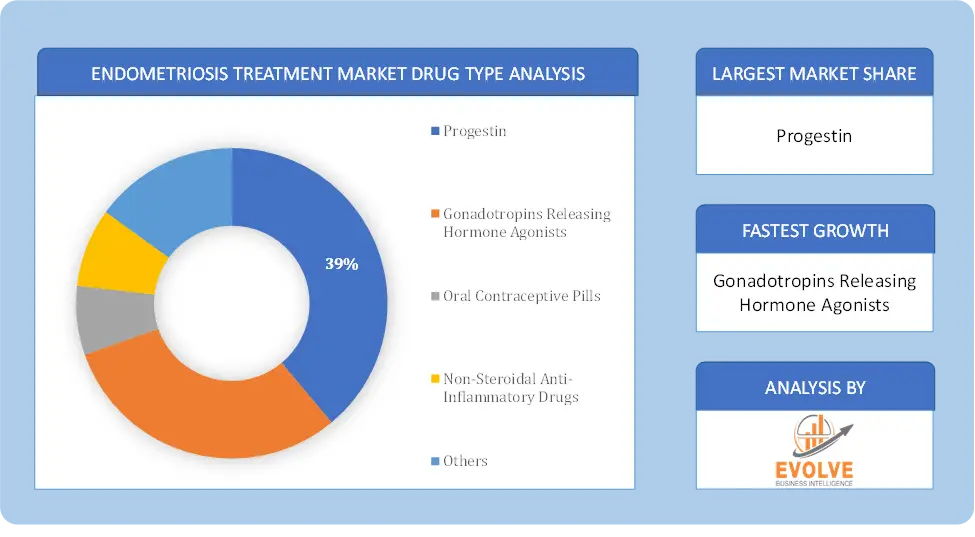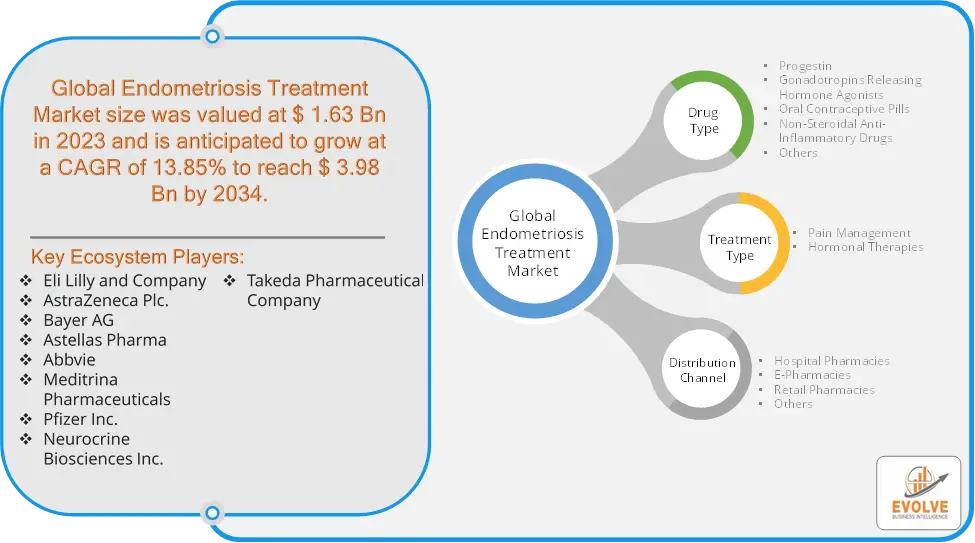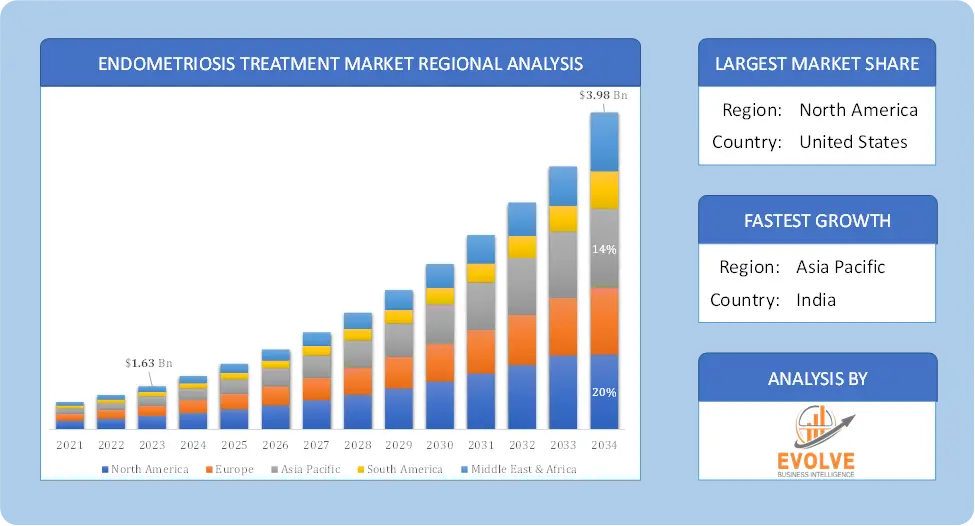Global Endometriosis Treatment Market Analysis and Global Forecast 2024-2034
$ 1,390.00 – $ 5,520.00Price range: $ 1,390.00 through $ 5,520.00
Global Endometriosis Treatment Market Research Report: Information By Drug Type (Progestin, Gonadotropins Releasing Hormone Agonists, Oral Contraceptive Pills, Non-Steroidal Anti-Inflammatory Drugs, and Others) By Treatment Type (Pain Management and Hormonal Therapies), By Distribution Channel (Hospital Pharmacies, E-Pharmacies, Retail Pharmacies, and Others), and by Region — Forecast till 2034
Page: 160
Global Endometriosis Treatment Market Overview
The Global Endometriosis Treatment Market size accounted for USD 1.63 Billion in 2023 and is estimated to account for 2.05 Billion in 2024. The Market is expected to reach USD 3.98 Billion by 2034 growing at a compound annual growth rate (CAGR) of 13.85% from 2024 to 2034. The Global Endometriosis Treatment Market refers to the industry focused on the development, production, and distribution of treatments for endometriosis, a chronic condition in which tissue similar to the lining inside the uterus grows outside of it, causing pain, infertility, and other complications.
The global endometriosis treatment market is a growing industry with significant potential to improve the lives of millions of women affected by this condition. The Key factor is driven by increasing awareness of endometriosis, advancements in diagnostic techniques and the development of new, more effective therapies.
Global Endometriosis Treatment Market Synopsis
 Global Endometriosis Treatment Market Dynamics
Global Endometriosis Treatment Market Dynamics
The major factors that have impacted the growth of Global Endometriosis Treatment Market are as follows:
Drivers:
⮚ Technological Advancements
Improved diagnostic methods, such as laparoscopy and non-invasive imaging techniques, enable earlier detection, driving the demand for treatments. Rising healthcare spending globally, particularly in women’s health, supports the availability and access to endometriosis treatments. The growing preference for minimally invasive surgeries like laparoscopy for the treatment of endometriosis is driving the surgical treatment segment. As endometriosis is a chronic and often recurring condition, the long-term demand for medical management, ongoing treatments, and pain relief medications contributes to sustained market growth.
Restraint:
- Perception of High Cost of Treatment and Delayed Diagnosis
The cost of endometriosis treatments, including surgeries, hormonal therapies, and long-term medication, can be prohibitive for many patients, limiting market growth. Endometriosis is often underdiagnosed or misdiagnosed due to the complexity of its symptoms, with many women waiting years for a proper diagnosis. This delay reduces the potential patient pool seeking treatment.
Opportunity:
⮚ Improved Diagnostic Tools
Advances in non-invasive diagnostics, such as biomarker-based tests or advanced imaging techniques, offer opportunities for earlier and more accurate detection of endometriosis, expanding the treatment market. The trend toward personalized or precision medicine offers opportunities to develop customized treatment plans based on individual patient profiles, improving outcomes and patient satisfaction. The rise of telemedicine and digital health platforms offers new channels for managing endometriosis, particularly in remote areas where access to specialist care is limited. These platforms can facilitate patient education, symptom tracking, and follow-up care.
Global Endometriosis Treatment Market Segment Overview
By Drug Type
 Based on Drug Type, the market is segmented based on Progestin, Gonadotropins Releasing Hormone Agonists, Oral Contraceptive Pills, Non-Steroidal Anti-Inflammatory Drugs, and Others. The Oral Contraceptive Pills segment dominant the market. The dominance of oral contraceptives is attributed to their effectiveness in controlling hormonal fluctuations, reducing pain, and managing the progression of endometriosis, making them a widely accepted and prescribed treatment choice. Furthermore, the fastest-growing category is GnRH Analogues, driven by their efficacy in suppressing ovarian function and reducing estrogen levels, thereby alleviating endometriosis symptoms.
Based on Drug Type, the market is segmented based on Progestin, Gonadotropins Releasing Hormone Agonists, Oral Contraceptive Pills, Non-Steroidal Anti-Inflammatory Drugs, and Others. The Oral Contraceptive Pills segment dominant the market. The dominance of oral contraceptives is attributed to their effectiveness in controlling hormonal fluctuations, reducing pain, and managing the progression of endometriosis, making them a widely accepted and prescribed treatment choice. Furthermore, the fastest-growing category is GnRH Analogues, driven by their efficacy in suppressing ovarian function and reducing estrogen levels, thereby alleviating endometriosis symptoms.
By Treatment Type
Based on Treatment Type, the market segment has been divided into Pain Management and Hormonal Therapies. The Hormonal Therapies segment dominant the market. Hormonal therapy, including options like oral contraceptives and GnRH analogues, is widely prescribed due to its effectiveness in managing hormonal imbalances, alleviating pain, and controlling the progression of endometriosis. Conversely, the fastest-growing category is Pain Management. The focus on pain management in endometriosis treatment has gained prominence as it addresses a critical aspect of the condition. With a growing emphasis on enhancing the quality of life for individuals with endometriosis, innovative pain management strategies and medications are witnessing increased adoption to provide relief from the often-debilitating pain associated with the condition.
By Distribution Channel
Based on Distribution Channel, the market segment has been divided into Hospital Pharmacies, E-Pharmacies, Retail Pharmacies, and Others. The Hospital Pharmacies segment dominant the market. Hospital pharmacies play a crucial role in dispensing medications and facilitating treatment plans prescribed by healthcare professionals. Conversely, the fastest-growing category is e-Commerce. The online platform is experiencing rapid growth in the distribution of endometriosis treatment products. This growth is fueled by the increasing trend of patients seeking convenience, privacy, and a wider range of product choices through digital channels.
Global Endometriosis Treatment Market Regional Analysis
Based on region, the Global Endometriosis Treatment Market has been divided into North America, Europe, Asia-Pacific, the Middle East & Africa, and Latin America. North America is projected to dominate the use of the Global Endometriosis Treatment Market followed by the Asia-Pacific and Europe regions.
 Global Endometriosis Treatment North America Market
Global Endometriosis Treatment North America Market
North America holds a dominant position in the Global Endometriosis Treatment Market. The largest market share due to high awareness levels, well-developed healthcare infrastructure, and significant healthcare expenditure. Availability of advanced treatment options, strong presence of pharmaceutical companies, high prevalence of endometriosis, and growing patient awareness. The largest market for endometriosis treatment, driven by a strong healthcare infrastructure, high prevalence of the condition, and significant research and development efforts.
Global Endometriosis Treatment Asia-Pacific Market
The Asia-Pacific region has indeed emerged as the fastest-growing market for the Global Endometriosis Treatment Market industry. The largest market in the Asia-Pacific region, driven by a growing population, increasing awareness of women’s health, and rising disposable incomes. Fastest-growing region due to increasing healthcare expenditure, rising awareness, and a growing number of women being diagnosed with endometriosis and growing healthcare infrastructure, rising focus on women’s health, and increasing medical tourism in countries like India and Thailand.
Competitive Landscape
The Global Endometriosis Treatment Market is highly competitive, with numerous players offering a wide range of software solutions. The competitive landscape is characterized by the presence of established companies, as well as emerging startups and niche players. To increase their market position and attract a wide consumer base, the businesses are employing various strategies, such as product launches, and strategic alliances.
Prominent Players:
- Eli Lilly and Company
- AstraZeneca Plc.
- Bayer AG
- Astellas Pharma
- Abbvie
- Meditrina Pharmaceuticals
- Pfizer Inc.
- Neurocrine Biosciences Inc.
- Takeda Pharmaceutical Company
Key Development
Scope of the Report
Global Endometriosis Treatment Market, by Drug Type
- Progestin
- Gonadotropins Releasing Hormone Agonists
- Oral Contraceptive Pills
- Non-Steroidal Anti-Inflammatory Drugs
- Others
Global Endometriosis Treatment Market, by Treatment Type
- Pain Management
- Hormonal Therapies
Global Endometriosis Treatment Market, by Distribution Channel
- Hospital Pharmacies
- E-Pharmacies
- Retail Pharmacies
- Others
Global Endometriosis Treatment Market, by Region
- North America
- US
- Canada
- Mexico
- Europe
- UK
- Germany
- France
- Italy
- Spain
- Benelux
- Nordic
- Rest of Europe
- Asia Pacific
- China
- Japan
- South Korea
- Indonesia
- Austalia
- Malaysia
- India
- Rest of Asia Pacific
- South America
- Brazil
- Argentina
- Rest of South America
- Middle East & Africa
- Saudi Arabia
- UAE
- Egypt
- South Africa
- Rest of Middle East & Africa
| Parameters | Indicators |
|---|---|
| Market Size | 2033: $3.98 Billion |
| CAGR | 13.85% CAGR (2023-2033) |
| Base year | 2022 |
| Forecast Period | 2023-2033 |
| Historical Data | 2021 |
| Report Coverage | Revenue Forecast, Competitive Landscape, Growth Factors, and Trends |
| Key Segmentations | Drug Type, Treatment Type, Distribution Channel |
| Geographies Covered | North America, Europe, Asia-Pacific, Latin America, Middle East, Africa |
| Key Vendors | Eli Lilly and Company, AstraZeneca Plc., Bayer AG, Astellas Pharma, Abbvie, Meditrina Pharmaceuticals, Pfizer Inc., Neurocrine Biosciences Inc. and Takeda Pharmaceutical Company. |
| Key Market Opportunities | • Improved Diagnostic Tools • Rising Focus on Personalized Medicine |
| Key Market Drivers | • Technological Advancements • Rising Demand for Minimally Invasive Surgeries |
REPORT CONTENT BRIEF:
- High-level analysis of the current and future Global Endometriosis Treatment Market trends and opportunities
- Detailed analysis of current market drivers, restraining factors, and opportunities in the future
- Global Endometriosis Treatment Market historical market size for the year 2021, and forecast from 2023 to 2033
- Global Endometriosis Treatment Market share analysis at each product level
- Competitor analysis with detailed insight into its product segment, Government & Defense strength, and strategies adopted.
- Identifies key strategies adopted including product launches and developments, mergers and acquisitions, joint ventures, collaborations, and partnerships as well as funding taken and investment done, among others.
- To identify and understand the various factors involved in the Global Endometriosis Treatment Market affected by the pandemic
- To provide a detailed insight into the major companies operating in the market. The profiling will include the Government & Defense health of the company’s past 2-3 years with segmental and regional revenue breakup, product offering, recent developments, SWOT analysis, and key strategies.
Press Release

Global Pharmaceutical Manufacturing Market to Reach $1.38 Trillion by 2035 with 7.35% CAGR, New Research Shows

The Global Mammography Market Is Estimated To Record a CAGR of Around 10.29% During The Forecast Period

Glue Stick Market to Reach USD 2.35 Billion by 2034

Podiatry Service Market to Reach USD 11.88 Billion by 2034

Microfluidics Technology Market to Reach USD 32.58 Billion by 2034

Ferric Chloride Market to Reach USD 10.65 Billion by 2034

Family Practice EMR Software Market to Reach USD 21.52 Billion by 2034

Electric Hairbrush Market to Reach USD 15.95 Billion by 2034

Daily Bamboo Products Market to Reach USD 143.52 Billion by 2034

Cross-border E-commerce Logistics Market to Reach USD 112.65 Billion by 2034
Frequently Asked Questions (FAQ)
What is the study period of this market?
The study period of the Global Endometriosis Treatment Market is 2021- 2033
What is the growth rate of the Global Endometriosis Treatment Market?
The Global Endometriosis Treatment Market is growing at a CAGR of 13.85% over the next 10 years
Which region has the highest growth rate in the market of Global Endometriosis Treatment Market?
Asia Pacific is expected to register the highest CAGR during 2024-2034
Which region has the largest share of the Global Endometriosis Treatment Market?
North America holds the largest share in 2022
Who are the key players in the Global Endometriosis Treatment Market?
Eli Lilly and Company, AstraZeneca Plc., Bayer AG, Astellas Pharma, Abbvie, Meditrina Pharmaceuticals, Pfizer Inc., Neurocrine Biosciences Inc. and Takeda Pharmaceutical Company. are the major companies operating in the market.
Do you offer Post Sale Support?
Yes, we offer 16 hours of analyst support to solve the queries
Do you sell particular sections of a report?
Yes, we provide regional as well as country-level reports. Other than this we also provide a sectional report. Please get in contact with our sales representatives
Table of Contents
Chapter 1. Executive Summary Chapter 2. Scope Of Study 2.1. Market Definition 2.2. Scope Of The Study 2.2.1. Objectives of Report 2.2.2. Limitations 2.3. Market Structure Chapter 3. Evolve BI Methodology Chapter 4. Market Insights and Trends 4.1. Supply/ Value Chain Analysis 4.1.1. Raw Application Providers 4.1.2. Manufacturing Process 4.1.3. Distributors/Retailers 4.1.4. End Users 4.2. Porter’s Five Forces Analysis 4.2.1. Threat Of New Entrants 4.2.2. Bargaining Power Of Buyers 4.2.3. Bargaining Power Of Suppliers 4.2.4. Threat Of Substitutes 4.2.5. Industry Rivalry 4.3. Impact Of COVID-19 on Endometriosis Treatment 4.3.1. Impact on Market Size 4.3.2. End-User Trend, Preferences, and Budget Impact 4.3.3. Regulatory Framework/Government Policies 4.3.4. Key Players' Strategy to Tackle Negative Impact 4.3.5. Opportunity Window 4.4. Technology Overview 4.5. Macro factor 4.6. Micro Factor 4.7. Demand Supply Gap Analysis of Endometriosis Treatment 4.8. Import Analysis of Endometriosis Treatment 4.9. Export Analysis of Endometriosis Treatment Chapter 5. Market Dynamics 5.1. Introduction 5.2. DROC Analysis 5.2.1. Drivers 5.2.2. Restraints 5.2.3. Opportunities 5.2.4. Challenges 5.3. Patent Analysis 5.4. Industry Roadmap 5.5. Parent/Peer Market Analysis Chapter 6. Global Endometriosis Treatment, By Drug Type 6.1. Introduction 6.2. Progestin 6.3. Gonadotropins Releasing Hormone Agonists 6.4. Oral Contraceptive Pills 6.5. Non-Steroidal Anti-Inflammatory Drugs 6.6 Others Chapter 7. Global Endometriosis Treatment, By Treatment Type 7.1. Introduction 7.2. Hormonal Therapies 7.3. Pain Management Chapter 8. Global Endometriosis Treatment, By Distribution Channel 8.1. Introduction 8.2. Hospital Pharmacies 8.3. E-Pharmacies 8.4 Retail Pharmacies 8.5 Others Chapter 9. Global Endometriosis Treatment, By Region 9.1. Introduction 9.2. North America 9.2.1. Introduction 9.2.2. Driving Factors, Opportunity Analyzed, and Key Trends 9.2.3. Market Size and Forecast, By Country, 2020 - 2028 9.2.4. Market Size and Forecast, By Product Type, 2020 - 2028 9.2.5. Market Size and Forecast, By Application, 2020 – 2028 9.2.6. US 9.2.6.1. Introduction 9.2.6.2. Driving Factors, Opportunity Analyzed, and Key Trends 9.2.6.3. Market Size and Forecast, By Product Type, 2020 - 2028 9.2.6.4. Market Size and Forecast, By Application, 2020 - 2028 9.2.7. Canada 9.2.7.1. Introduction 9.2.7.2. Driving Factors, Opportunity Analyzed, and Key Trends 9.2.7.3. Market Size and Forecast, By Product Type, 2020 - 2028 9.2.7.4. Market Size and Forecast, By Application, 2020 - 2028 9.3. Europe 9.3.1. Introduction 9.3.2. Driving Factors, Opportunity Analyzed, and Key Trends 9.3.3. Market Size and Forecast, By Country, 2020 - 2028 9.3.4. Market Size and Forecast, By Product Type, 2020 - 2028 9.3.5. Market Size and Forecast, By Application, 2020 – 2028 9.3.6. Germany 9.3.6.1. Introduction 9.3.6.2. Driving Factors, Opportunity Analyzed, and Key Trends 9.3.6.3. Market Size and Forecast, By Product Type, 2020 - 2028 9.3.6.4. Market Size and Forecast, By Application, 2020 - 2028 9.3.7. France 9.3.7.1. Introduction 9.3.7.2. Driving Factors, Opportunity Analyzed, and Key Trends 9.3.7.3. Market Size and Forecast, By Product Type, 2020 - 2028 9.3.7.4. Market Size and Forecast, By Application, 2020 - 2028 9.3.8. UK 9.3.8.1. Introduction 9.3.8.2. Driving Factors, Opportunity Analyzed, and Key Trends 9.3.8.3. Market Size and Forecast, By Product Type, 2020 - 2028 9.3.8.4. Market Size and Forecast, By Application, 2020 - 2028 9.3.9. Italy 9.3.9.1. Introduction 9.3.9.2. Driving Factors, Opportunity Analyzed, and Key Trends 9.3.9.3. Market Size and Forecast, By Product Type, 2020 - 2028 9.3.9.4. Market Size and Forecast, By Application, 2020 - 2028 9.3.10. Rest Of Europe 9.3.10.1. Introduction 9.3.10.2. Driving Factors, Opportunity Analyzed, and Key Trends 9.3.10.3. Market Size and Forecast, By Product Type, 2020 - 2028 9.3.10.4. Market Size and Forecast, By Application, 2020 - 2028 9.4. Asia-Pacific 9.4.1. Introduction 9.4.2. Driving Factors, Opportunity Analyzed, and Key Trends 9.4.3. Market Size and Forecast, By Country, 2020 - 2028 9.4.4. Market Size and Forecast, By Product Type, 2020 - 2028 9.4.5. Market Size and Forecast, By Application, 2020 - 2028 9.4.6. China 9.4.6.1. Introduction 9.4.6.2. Driving Factors, Opportunity Analyzed, and Key Trends 9.4.6.3. Market Size and Forecast, By Product Type, 2020 - 2028 9.4.6.4. Market Size and Forecast, By Application, 2020 - 2028 9.4.7. India 9.4.7.1. Introduction 9.4.7.2. Driving Factors, Opportunity Analyzed, and Key Trends 9.4.7.3. Market Size and Forecast, By Product Type, 2020 - 2028 9.4.7.4. Market Size and Forecast, By Application, 2020 - 2028 9.4.8. Japan 9.4.8.1. Introduction 9.4.8.2. Driving Factors, Opportunity Analyzed, and Key Trends 9.4.8.3. Market Size and Forecast, By Product Type, 2020 - 2028 9.4.8.4. Market Size and Forecast, By Application, 2020 - 2028 9.4.9. South Korea 9.4.9.1. Introduction 9.4.9.2. Driving Factors, Opportunity Analyzed, and Key Trends 9.4.9.3. Market Size and Forecast, By Product Type, 2020 - 2028 9.4.9.4. Market Size and Forecast, By Application, 2020 - 2028 9.4.10. Rest Of Asia-Pacific 9.4.10.1. Introduction 9.4.10.2. Driving Factors, Opportunity Analyzed, and Key Trends 9.4.10.3. Market Size and Forecast, By Product Type, 2020 - 2028 9.4.10.4. Market Size and Forecast, By Application, 2020 - 2028 9.5. Rest Of The World (RoW) 9.5.1. Introduction 9.5.2. Driving Factors, Opportunity Analyzed, and Key Trends 9.5.3. Market Size and Forecast, By Product Type, 2020 - 2028 9.5.4. Market Size and Forecast, By Application, 2020 - 2028 9.5.5. Market Size and Forecast, By Region, 2020 - 2028 9.5.6. South America 9.5.6.1. Introduction 9.5.6.2. Driving Factors, Opportunity Analyzed, and Key Trends 9.5.6.3. Market Size and Forecast, By Product Type, 2020 - 2028 9.5.6.4. Market Size and Forecast, By Application, 2020 - 2028 9.5.7. Middle East and Africa 9.5.7.1. Introduction 9.5.7.2. Driving Factors, Opportunity Analyzed, and Key Trends 9.5.7.3. Market Size and Forecast, By Product Type, 2020 - 2028 9.5.7.4. Market Size and Forecast, By Application, 2020 - 2028 Chapter 10. Competitive Landscape 10.1. Introduction 10.2. Vendor Share Analysis, 2020/Key Players Positioning, 2020 Chapter 11. Company Profiles 11.1. Astra Zeneca Plc. 11.1.1. Business Overview 11.1.2. Financial Analysis 11.1.3. Product Portfolio 11.1.4. Recent Development and Strategies Adopted 11.1.5. SWOT Analysis 11.2. Eli Lilly and Company 11.2.1. Business Overview 11.2.2. Financial Analysis 11.2.3. Product Portfolio 11.2.4. Recent Development and Strategies Adopted 11.2.5. SWOT Analysis 11.3. Astellas Pharma 11.3.1. Business Overview 11.3.2. Financial Analysis 11.3.3. Product Portfolio 11.3.4. Recent Development and Strategies Adopted 11.3.5. SWOT Analysis 11.4. Bayer AG 11.4.1. Business Overview 11.4.2. Financial Analysis 11.4.3. Product Portfolio 11.4.4. Recent Development and Strategies Adopted 11.4.5. SWOT Analysis 11.5. Meditrina Pharmaceuticals 11.5.1. Business Overview 11.5.2. Financial Analysis 11.5.3. Product Portfolio 11.5.4. Recent Development and Strategies Adopted 11.5.5. SWOT Analysis 11.6. Abbvie 11.6.1. Business Overview 11.6.2. Financial Analysis 11.6.3. Product Portfolio 11.6.4. Recent Development and Strategies Adopted 11.6.5. SWOT Analysis 11.7. Pfizer Inc. 11.7.1. Business Overview 11.7.2. Financial Analysis 11.7.3. Product Portfolio 11.7.4. Recent Development and Strategies Adopted 11.7.5. SWOT Analysis 11.8. Takeda Pharmaceutica 11.8.1. Business Overview 11.8.2. Financial Analysis 11.8.3. Product Portfolio 11.8.4. Recent Development and Strategies Adopted 11.8.5. SWOT Analysis 11.9. Neurocrine Biosciences Inc. 11.9.1. Business Overview 11.9.2. Financial Analysis 11.9.3. Product Portfolio 11.9.4. Recent Development and Strategies Adopted 11.9.5. SWOT Analysis Chapter 12. Key Takeaways
Connect to Analyst
Research Methodology

Our Most Viewed Report and gain instant expertise
3D Printing Medical Devices Market Analysis and Global Forecast 2023-2033
Aesthetic Market Analysis and Global Forecast 2023-2033
Androgen Replacement Therapy Market Analysis and Global Forecast 2023-2033
COVID-19 Diagnostics Market Analysis and Global Forecast 2023-2033
COVID-19 Diagnostics Market Research Report: Information By Product (PCR Kits, POC Test, Immunoassay Test, Others), By Technology (Molecular, Immunoassay, Others), By End-User (Hospitals, Diagnostic Labs, Physician’s office and urgent care clinics, Others), and by Region — Forecast till 2033
Page: 160Emergency Medical Supplies Market Analysis and Global Forecast 2023-2033
Heart Rate Monitor Market Analysis and Global Forecast 2023-2033
Pharmacogenomics Market Analysis and Global Forecast 2023-2033
Telemedicine Market Analysis and Global Forecast 2023-2033
Press Release: https://evolvebi.com/the-telemedicine-market-is-estimated-to-record-a-cagr-of-around-29-2-during-the-forecast-period 





